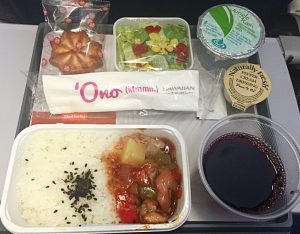Route: Honolulu to San Francisco
Aircraft: Airbus 330
Flight time: 4 hours, 50 minutes
Seats: Economy, 18A and B
Honolulu airport is like stepping back in time. It doesn’t look to have been updated since the 1980s and its facilities are tired and old. Signage on arrival for a domestic flight is poor and, if not for the assistance of a kind Hawaiian Airlines staff member, we would never have found where to check in our bags or, indeed, discover the procedure to follow.
In a nutshell, check-in is done at a self-service kiosk, where you pay for any checked bags. The machine spits out boarding passes and bag tags. You’re then required to queue up with luggage to clear ‘agricultural screening’, which is necessary for any flights to the US mainland.
The next queue is for the TSA check. We were fortunate enough to have the TSA ‘pre-check tick’ on our boarding passes – a much shorter queue and the agent tried his very best ‘G’day mate’ on sighting our Australian passports.
Unlike domestic travel in Australia, however, there are the same liquid restrictions to pass through security at any US airport as we are used to for international flights. There are water fountains airside to refill empty bottles.
Then it’s a route march to your gate – if you’ve dressed for your destination rather than the tropical heat of Hawaii, be aware a fair amount of your walk is likely to be in the open air.
But that’s not the end of security checks; passengers to the mainland also undergo a further agricultural screening of their hand luggage. We took some apples from the hotel that morning, intending to munch on them on the plane. Hah. They went into the quarantine bin.
The gate lounges are big, with enough seating but Honolulu airport continues to buck the trend of allowing free wi-fi access – even for a short timespan. As this post was published, 2 hours of wi-fi is a whopping US$8.95.
Boarding is crazy. There’s only one gate agent checking boarding passes and the queues are long and chaotic. A large group of Asian visitors tries to board as soon as possible and, when told their ‘zone’ hadn’t been called yet, congregate around the doorway, blocking everyone else’s access.
The wide-body Airbus is in a 2-4-2 configuration. We take 18A and B and have around 32 inches of seat pitch – not too bad for leg room. In-flight entertainment is through seat back touch screens but free options are extremely limited. We opt to just run the flight tracker. Screens incorporate a USB port but an onscreen notice warns ‘larger devices’ such as iPads will not charge.
Push back is five minutes late, but a tail wind across the Pacific allows us to land just ahead of schedule at SFO at 8.57pm local time. The flight attendants are friendly and warm and offer two free items of service – drinks and snacks first up, followed by a dinner service with a complimentary glass of red or white wine. We opted for red, which turned out to be a passable Merlot.
There is no food choice in the economy cabin – the tray includes sweet-and-sour chicken and rice, a small salad, dressing, a macaroon and a tub of water.
Arrival at SFO is marred by a technical problem which results in over an hour’s wait for luggage.
Verdict
While the in-flight experience was quite comfortable, glitches in processes at both airports were very frustrating. This is the second time we’ve flown Hawaiian; on the first flight we opted for the premium economy cabin (a ‘quiet’ zone, just behind business class, in the forward section of the plane). Having experienced standard economy, it didn’t seem to be much more of a benefit.






Comments